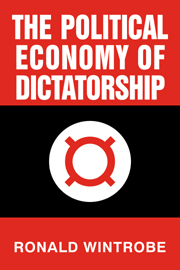Book contents
- Frontmatter
- Contents
- Dedication
- Acknowledgments
- Part I Introduction
- Part II Equilibrium political repression
- Part III Economics of autocracy
- 6 The economy of dictatorship
- 7 Redistribution and rent-seeking
- 8 Apartheid
- 9 The bureaucratic economy I: the model
- 10 The bureaucratic economy II: rise and fall
- Part IV The dynamics of dictatorship
- Part V Conclusion
- References
- Name index
- Subject index
9 - The bureaucratic economy I: the model
Published online by Cambridge University Press: 05 June 2012
- Frontmatter
- Contents
- Dedication
- Acknowledgments
- Part I Introduction
- Part II Equilibrium political repression
- Part III Economics of autocracy
- 6 The economy of dictatorship
- 7 Redistribution and rent-seeking
- 8 Apartheid
- 9 The bureaucratic economy I: the model
- 10 The bureaucratic economy II: rise and fall
- Part IV The dynamics of dictatorship
- Part V Conclusion
- References
- Name index
- Subject index
Summary
The Soviet experience
This chapter and the next one are devoted to the economics of communism. In an attempt to understand how these systems work, one good place to start is with the fact that within the planning sector (comprising, for example, roughly 80 percent of the 46,000 industrial enterprises located throughout the former Soviet Union in the mid-1980s), the use of money is severely circumscribed. Thus, “in the Soviet banking system the absolute order to pay is unknown; payments from any account are made only if in agreement with the applicable rules and authorizations.” Similarly, in China prior to 1979, only currency in circulation was considered by the authorities to be money, and monetary policy consisted primarily of regulating the amount of currency in circulation. Individual households could hold savings and time deposits in banks, but not checkable deposits. The “transfer balances” of government agencies and enterprises were transferable only with explicit hierarchical approval. Before giving approval, the banks in each case had to ensure both that the transaction had received prior authorization by the proper authorities in accordance with the economic plan and that all papers relating to the transaction were in order (see Cheng 1987 for details).
Consequently, a distinction became popular between “active money” and “passive money” (Wiles 1962). Passive money (the transfer balances of enterprises) may be a decision-making criterion for the planners but not for the enterprises.
- Type
- Chapter
- Information
- The Political Economy of Dictatorship , pp. 197 - 217Publisher: Cambridge University PressPrint publication year: 1998



